
|   |

|   |
 e-mail: sunilkothari1933@gmail.com Shraddhanjali: Nupur Zankar pays tribute to Pt Vijay Shankar Photos: AMK Fotography February 11, 2020 When you entered the Saradar Patel Sabhagraha Auditorium of Bharatiya Vidya Bhavan at Andheri West in Mumbai on 26th January, you saw on the stage a large photograph of the gently smiling late Kathak exponent Pandit Vijay Shankar, a disciple of Pandit Birju Maharaj. On either side of the auditorium at strategic places were placed photos of, from Kolkata, Madhumita Roy, Sushmita Banerjee, Rama Prasad Chattopadhyaya and Sauvik Chakraborty, and of Asavari Pawar from Delhi. The photo of Shila Mehta, the organizer of the event, was also placed with them. She is from Kolkata and had studied under Vijay Shankar for many years. 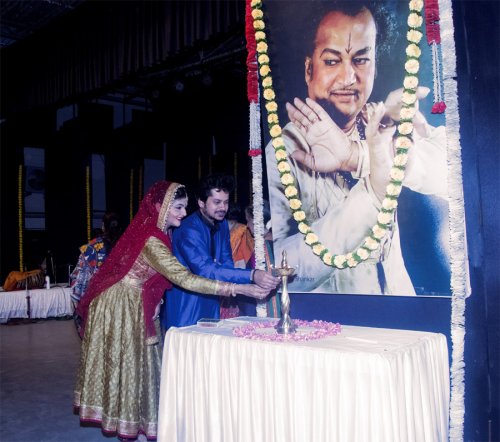 Pt. Vijay Shankar's son Shubham Maharaj and Shila Mehta It goes to the credit of Shila Mehta for planning Shraddhanjali in memory of her guru and invite his disciples and her contemporaries to pay tribute to him. After having studied under Birju Maharaj for a number of years, Vijay Shankar had moved to Kolkata. He started teaching Kathak there at Chetna Jalan's Padatik institute. His formidable reputation as a close disciple of Birju Maharaj and the training he had received from the maestro had reached far and wide. I was privileged to know him from his early career as he used to perform at Brijnarain's annual Swami Haridas Sammelan in Mumbai. A man of few words, Vijay Shankar's dance spoke to his audiences and connoisseurs. It was a pleasure to see him present Kathak at its best. I also remembered his role as Lakshmana with Brojen Mukherjee playing role of Rama in 'Katha Raghunath ki' choreographed by Birju Maharaj for Kathak Kendra. After Vijay Shankar's performances in Japan, his Japanese disciple established an institute for training in Kathak by Vijay Shankar. Vijay Shankar had choreographed many dance-dramas including 'Kshudhito Pashan,' 'Hungry Stones' of Rabindranath Tagore and a Japanese folk tale. When Shila Mehta moved to Mumbai, she started her own institute Nupur Zankar. She taught the repertoire of Vijay Shankar and also choreographed dance-dramas winning appreciation of connoisseurs in Mumbai. Being an enterprising dancer, when she visited Belgium, her Kathak performances were much appreciated and she was requested to visit at regular intervals and teach Kathak in Belgium. When her husband moved to New Jersey, USA, Shila engaged her senior students to continue teaching at her institution in Mumbai. Soon after she settled in New Jersey, she started teaching and performing there. She got an opportunity to perform in London and there too she was invited to teach at short intervals. However she kept Mumbai as her base, visiting it at regular intervals. Despite several activities going on, she always remembered her guru Vijay Shankar. Shraddhanajali featured different items his disciples had learnt from Vijay Shankar to showcase the variety of his legacy. Shila selected for herself items which were of slow tempo that would reveal the grace, beauty, delicacy of Lucknow gharana and highlight Vijay Shankar's training. Months ago she had visited New Delhi and from the archive of Sangeet Natak Akademi selected choice recordings of Vijay Shankar's Kathak. Before the performances by the artists, the video recording was screened and Shila drew attention to how Vijay Shankar performed, dancing what is termed as anaghat, his padhant, recitation of bols, his attempts to incorporate meend of music, and gamak while reciting bols and dancing 'gheghe gheghe' to reflect gamak in Kathak dance with mnemonic syllables and execute them through bodily movements. The foot work and, in particular the way the bols 'na dhin dhin na' were danced were captured well in the video and drew loud applause. 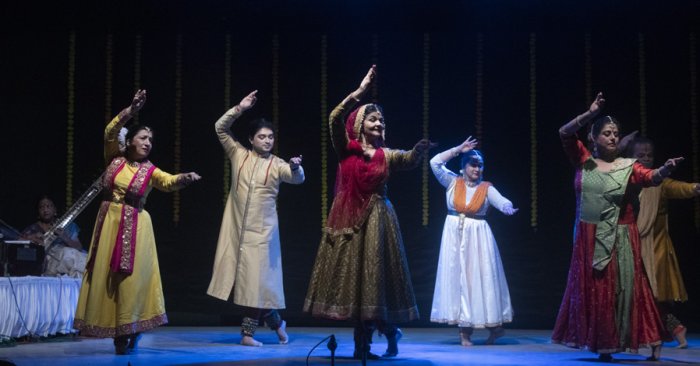 Fortunately Vijay Shankar's son Shubham Maharaj was specially invited to be a part of the celebrations and bring the archival material from SNA. He has from his very childhood studied under his maternal grandfather, the legendary tabla wizard Kishan Maharaj at Benaras. Today he is considered a bright young tabla player performing within India and abroad. He is based in Delhi and gives solo performances as well as participates in events like the one in memory of Ustad Allarakha, arranged by Zakir Hussain. The programme began with all dancers performing together paying tribute to Vijay Shankar seeking Guru kripa, blessing of the Guru. That set the tone. Shila presented in teen taal beginning in slow tempo instead of the razzle dazzle with which present day Kathak dancers begin their performances. Vijay Shankar believed in itminan, sukun, pleasantness in place of rapid fire chakkars. Shila wanted to draw the attention of the young generation to these aspects which are of late fast disappearing. Shila's ang in Kathak terminology has grace and with her tall and slim frame, she brings to the fore the nazaakat, grace and khoobsurati, beauty of Lucknow gharana. Her thaat was remarkable for the gentle movements of the wrists, arms, moving of the body and final pose. The tode, tukde, parans, tihais were arresting. She let other dancers display other aspects instead of taking more time to show her repertoire. That was befitting the occasion. Vijay Shankar used to say 'bhag daud mat karo' (do not run across the stage), 'pair mat patko' (do not strike feet while performing tatkar) and so on. Shila ended her presentation with 21 graceful chakkars.  Shila Mehta 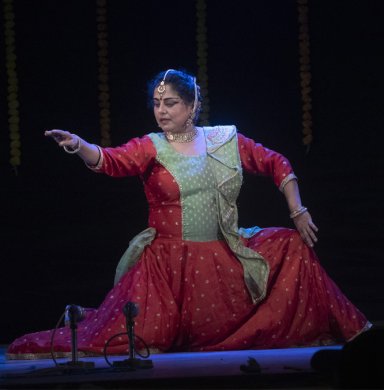 Madhumita Roy From Kolkata, Madhumita Roy recalled how Vijay Shankar emphasized balance and command over taal and laya. He used to say that the feeling of meditation must emerge from performing tatkar, foot work. He also cared for bhava paksha, the expressional aspect. After performing bandishes as taught to her by Vijay Shankar, Madhumita took up expressional number 'Bahut din par piya ghar aye', the nayika welcoming her beloved who had arrived after a long time. With lowered eyes, extended arms, the gentle walk backwards, inviting the nayak in, the feelings were expressed in gentle ways. The nayika decorated herself with ornaments, prepared the bed and suggested that she was ready for the love play. The graceful walk in gat, and movements while receding backwards were exquisite. Reverting to nirtta, Madhumita performed Jati paran and executed various tihais. In fast tempo, in druta, the bols 'takit takit takit' were danced bringing out the beauty of the bols with movement. With additional nritta, ginati and tukdas she was in her element. At special request by Shila, Madhumita enacted abhinaya to Suradasa's song 'Udho mohe braj bisarat nahi', 'O Uddhava', Krishna laments, ' I cannot forget Brij'. Vijay Shankar had specially choreographed the feeling of separation, viraha, Krishna experiences leaving Brij and going to Mathura. He recalls the bank of river Yamuna, the Kadamb tree, the shadow of the trees, 'taruvara chhaya', the birds, the cows and the flute . How can he forget the love of mother Yashoda, stealing butter and those games he played? Madhumita rendered it with complete involvement. Sushmita Banerjee began with Om Namah Shivaya and evoked the image of Shiva with three eyes, holding trident in hand, riding Nandi, having Ganga in his matted locks. After that she performed various items in nritta in teentaal.Vijay Shankar also loved teen taal. The command the dancers got with sadhana (practice) was evident in her presentation. In druta, fast tempo she reminded of old world charm of Kathak as it was performed in Kolkata in the eighties. Sushmita enacted abhinaya to Bindadin Maharaj's thumri 'Dagar chalat dekho Shyam kar ghaiyya' - when walking on the road, see how Krishna holds my hand and teases me. The various ways the Gopi displays the chhed chhad, Krishna's pranks were shown beautifully. The interesting way when Gopis catch hold of Krishna and surround him and dress him as a woman, 'Aaj ham nari banaye' - we shall do his hair, and put a sari on him. The poet says, 'But look how wonderful he looks in this dress' - 'Adbhut chhabi nyari'.  Sushmita Banerjee 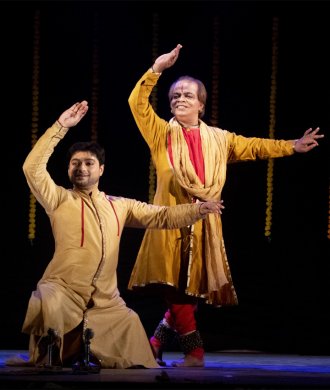 Sauvik Chakraborty & Rama Prasad Chattopadhyaya The two male dancers Rama Prasad Chattopadhyaya and Sauvik Chakraborty performed duet, beginning with Bindadin Maharaj's song 'Jhulat Radhe Naval Kishore'. Seated on the swing are Radha and Krishna. The swing has pillars which are studded with diamonds and precious stones, and when there is slight push, the swing creates illusion of watching the divine couple in their magnificent look. Sauvik and Rama Prasad alternated the stanzas and performed with feeling. In nritta, they executed in Dhamar, various Kathak numbers of tode, tukde, parans and also footwork. At times Sauvik would render the padhant and Rama Prasad would dance, and at times Rama Prasad would render padhant to which Sauvik would dance. Rama Prasad had more of theharava, less of exuberance, whereas Sauvik performed with more energy and excitement. Both of them danced with sincerity and total involvement. The finale was by Asavari Pawar, daughter of celebrated, 'gandabandha' shishya Pratap Pawar. She surprised the audience by singing an Urdu song which she explained was part of Kshudito Pashana, Hungry Stones dance drama choreographed by Vijay Shankar who had taught her that song. With endearing personality, she charmed away the audience and mentioned that though she was appearing last, she would perform with enthusiasm. In Kathak dance form, dancers have this liberty to talk directly with the audience. The audience enjoyed her jugalbandhi with the tabla player. 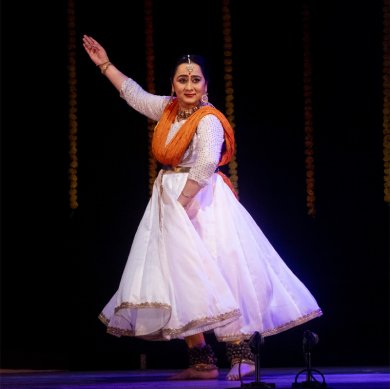 Asavari Pawar  Dr. Sunil Kothari is a dance historian, scholar, author and critic, Padma Shri awardee and fellow, Sangeet Natak Akademi. Dance Critics' Association, New York, has honoured him with Lifetime Achievement award. Post your comments Please provide your name and email id when you use the Anonymous profile in the blog to post a comment. All appropriate comments posted with name and email id in the blog will also be featured in the site. |